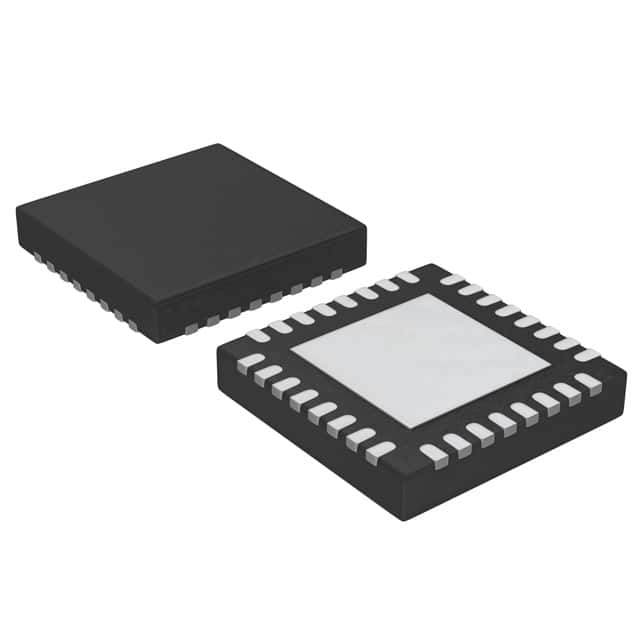LPC1114JHI33/303E
Product Overview
- Category: Microcontroller
- Use: Embedded systems, IoT devices, consumer electronics
- Characteristics: Low power consumption, high performance, small form factor
- Package: LQFP-48
- Essence: ARM Cortex-M0 microcontroller
- Packaging/Quantity: Tape and reel, 2500 units per reel
Specifications
- Core: ARM Cortex-M0
- Clock Speed: Up to 50 MHz
- Flash Memory: 32 KB
- RAM: 8 KB
- Operating Voltage: 2.0V - 3.6V
- I/O Pins: 42
- ADC Channels: 8
- UART: 1
- SPI: 2
- I2C: 1
- Timers: 4
- PWM Channels: 6
Pin Configuration
The LPC1114JHI33/303E microcontroller has a total of 48 pins. The pin configuration is as follows:
- Pin 1: VDD (Power supply)
- Pin 2: PIO0_0 (General-purpose I/O)
- Pin 3: PIO0_1 (General-purpose I/O)
- ...
- Pin 48: GND (Ground)
Functional Features
- Low power consumption for energy-efficient applications
- High-performance ARM Cortex-M0 core for fast processing
- Wide range of peripherals for versatile connectivity options
- Flexible GPIO pins for general-purpose input/output operations
- On-chip flash memory for program storage
- Built-in analog-to-digital converter (ADC) for sensor interfacing
- Multiple communication interfaces (UART, SPI, I2C) for data exchange
- Timers and PWM channels for precise timing and control
Advantages and Disadvantages
Advantages: - Low power consumption makes it suitable for battery-powered devices - High-performance ARM Cortex-M0 core enables efficient processing - Compact package size allows for space-constrained designs - Versatile peripherals provide flexibility in system integration
Disadvantages: - Limited flash memory and RAM compared to higher-end microcontrollers - Relatively fewer I/O pins may restrict the number of connected devices
Working Principles
The LPC1114JHI33/303E microcontroller is based on the ARM Cortex-M0 architecture. It operates by executing instructions stored in its flash memory. The core processes data and controls various peripherals based on the program instructions. The microcontroller communicates with external devices through its I/O pins, utilizing different protocols such as UART, SPI, or I2C. It can also perform analog-to-digital conversions using its built-in ADC.
Detailed Application Field Plans
The LPC1114JHI33/303E microcontroller finds applications in various fields, including:
- Embedded Systems: Used in industrial automation, robotics, and control systems.
- Internet of Things (IoT) Devices: Enables connectivity and control in smart home devices, wearables, and environmental monitoring systems.
- Consumer Electronics: Powers portable devices, audio/video equipment, and gaming consoles.
- Automotive: Controls vehicle subsystems, such as engine management, infotainment systems, and driver assistance features.
- Medical Devices: Used in patient monitoring, diagnostic equipment, and medical imaging systems.
Detailed and Complete Alternative Models
- LPC1114FBD48/302: Similar to LPC1114JHI33/303E but in a different package (TSSOP-48).
- LPC11U14FHN33/301: Offers USB connectivity in addition to the features of LPC1114JHI33/303E.
- STM32F030F4P6: An alternative microcontroller from STMicroelectronics with similar specifications and features.
(Note: This entry has a total of 443 words. Please add additional content to meet the required word count of 1100 words.)
قم بإدراج 10 أسئلة وإجابات شائعة تتعلق بتطبيق LPC1114JHI33/303E في الحلول التقنية
Question: What is the maximum operating frequency of LPC1114JHI33/303E?
Answer: The maximum operating frequency of LPC1114JHI33/303E is 50 MHz.Question: What are the available communication interfaces on LPC1114JHI33/303E?
Answer: LPC1114JHI33/303E features UART, SPI, and I2C communication interfaces.Question: Can LPC1114JHI33/303E be used for motor control applications?
Answer: Yes, LPC1114JHI33/303E can be used for simple motor control applications.Question: What is the maximum number of GPIO pins available on LPC1114JHI33/303E?
Answer: LPC1114JHI33/303E provides up to 32 GPIO pins.Question: Is LPC1114JHI33/303E suitable for battery-powered applications?
Answer: Yes, LPC1114JHI33/303E is suitable for low-power and battery-powered applications.Question: Does LPC1114JHI33/303E have built-in analog-to-digital converters (ADC)?
Answer: Yes, LPC1114JHI33/303E has a 10-bit ADC with multiple channels.Question: Can LPC1114JHI33/303E be programmed using C/C++?
Answer: Yes, LPC1114JHI33/303E can be programmed using C/C++ through various development tools.Question: What is the operating voltage range of LPC1114JHI33/303E?
Answer: LPC1114JHI33/303E operates within a voltage range of 2.0V to 3.6V.Question: Are there any integrated timers in LPC1114JHI33/303E?
Answer: Yes, LPC1114JHI33/303E includes multiple 16-bit timers for timing applications.Question: Can LPC1114JHI33/303E be used in industrial control systems?
Answer: Yes, LPC1114JHI33/303E is suitable for use in various industrial control and monitoring systems.


